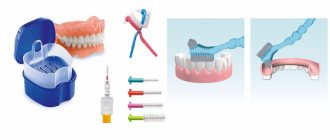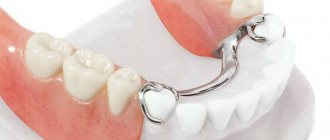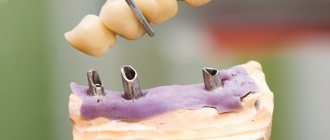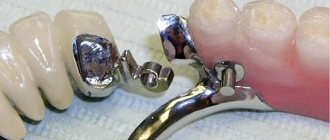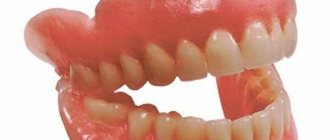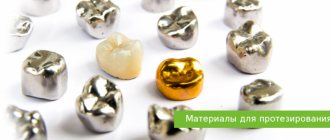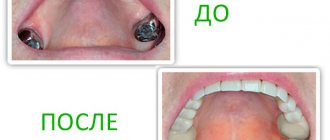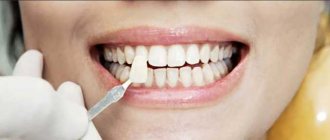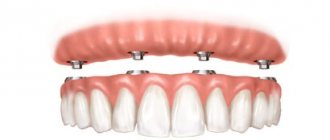The concept of a CAD system stands for computer-aided design. The dental system is designed to:
- for solving design problems, including three-dimensional design modeling;
- registration of digital text documentation and order control.
Modern CAD systems in dentistry realize the possibility of manufacturing all types of dental structures.
CAM systems are needed to design the process of processing products on CNC machines. The abbreviation CAM stands for computer-aided manufacturing. In a CAM system, the design basis is based on a three-dimensional model obtained through a CAD system.
What is CAD/CAM in prosthetic dentistry?
Innovative CAD/CAM technologies in orthopedic dentistry have made it possible to produce dentures in one visit, without the participation of a dental technician. In this case, the production of products is possible directly in the presence of the patient. The advantage of the method is cold processing of materials or, in other words, milling. This method is more gentle, it allows you to preserve the original properties of the material.
The idea of automated production of dental restorations appeared in 1970. It was possible to bring it to life only in 1983, introducing CAD/CAM into dentistry. Then, at the International Congress of Dentists, the first restoration made using this technology was demonstrated. The patient was the wife of Francis Duret, the developer of the miracle technology. Thus, with the support of Henson International, the Duret system was created, designed for modeling and production of restorations.
Today there are different systems, but the stages of CAD/CAM are similar for all.
- Obtaining information using a stationary scanner, contact profilometer or intraoral camera.
- Processing information using software, translating it into a coordinate system.
- Virtual simulation.
- Production of simulated restorations using milling equipment.
CAD (Computer Aided Design)
Computer-assisted design is the use of computer systems to design and develop a product. The computer is used as a highly advanced substitute for the drawing board, allowing three-dimensional modeling and design to be done without the need for pen and ink. A model created in such a system can be shown from any angle, and can also be simulated to view its projection in certain lighting conditions. Individual elements of the drawing can be revised, replaced, and the entire model as a whole can be rebuilt. Once the design has been finalized, detailed and dimensioned drawings can be printed for use in the manufacturing process. Or, on the other hand, they can be passed on and the information regarding the shape of the part can be turned into manufacturing instructions that will be transmitted directly to the machines that produce the part.
In particularly advanced systems, it is possible to also take into account the structural properties of the materials. Mathematical modeling of a structure using these quantities makes it possible to obtain an assessment of certain aspects of its behavior even before it leaves the drawing board. This technique is known as finite element analysis. It is possible to evaluate the consequences of certain changes in the design in relation to the behavior of the part, even before it is manufactured, even in the form of a physical model.
Advantages of CAD/CAM technologies in dentistry
In the dental industry, dental structures made of zirconium are very popular. They do not have a metal base and look natural. Only CAD/CAM systems can produce such products. This is not the only advantage of the technology; there are other important and noteworthy advantages:
- highest manufacturing precision;
- short production times;
- taking into account the characteristics and needs of the patient;
- an automated process that eliminates human errors.
Different CAD/CAM systems used in dentistry have their own advantages. Currently there are closed and open types. The latter work only with specific materials - disks, blocks, etc. Open ones are valued for the ability to update the software, for example, to work with other equipment.
From the technical side, several advantages can also be identified.
- The material does not deform, which allows us to obtain a high-quality product that meets the specified parameters.
- Visualization of not only the final, but also intermediate results, the opportunity to discuss and agree on everything with the patient.
- The use of different materials for orthopedic structures.
Brief overview of different models
CAD/CAM systems used in our country:
- Cerec;
- Katana;
- Organic, etc.
Overview of Dyamach systems
For the manufacture of prosthetic structures, open type DT2 milling equipment is used, which makes it possible to use almost any materials, including metals, polymers, ceramics, etc. It has increased accuracy, and the machine can operate continuously.
Advantages of models from this manufacturer:
- wide angle of rotation of the working axes (A by 360 degrees, B by +/- 43 degrees);
- spindle movement at high speed (up to 60,000 rpm);
- the ability to process complex metal structures and abutments (in particular, titanium);
- a wider range of cutters used (from 3 to 6 mm), while many similar models are limited to only 6 mm cutters;
- have a lower cost compared to other professional equipment;
- Less time is spent on milling.
Dyamach equipment
Interesting! The Dyamach DT-2 machine is equipped with a Mitsubishi engine, it allows you to increase the accuracy and speed of work. This system has an ideal price-quality ratio.
Overview of Roland systems (made in Japan)
These open systems feature reduced noise levels and extremely high precision in the production of zirconium products.
The advantages of the DWX 51D milling unit include the following factors:
- it is possible to process zirconium crowns with high precision; metal-free material Trinia, which has an increased level of strength, can be used;
- you can perform work simultaneously on five axes;
- accuracy is increased due to the fact that the tilt angle along the B axis is larger up to 30 degrees;
- It takes about 30 minutes to make one crown; if two are made at the same time, then the time does not exceed 45 minutes, therefore, when processing several workpieces at once, the time for one becomes less. 20 crowns will take approximately 6 hours;
- due to the special shape of the disc holder, the possibility of rotation is excluded;
- a cutter auto-change mechanism has been implemented;
- The device is equipped with an ionizer.
Roland Equipment
Here's what we can say about the DWX 4W glass-ceramic milling machine:
- you can work on three workpieces without stopping, which significantly increases the speed of work;
- it is possible to work with glass-ceramic workpieces;
- diamond cutters;
- milling can be performed along four axes with a rotation angle of 360 degrees;
- the ability to automatically feed tools at four stations is organized;
- spindle speed 60,000 rpm (Jaeger);
- water cooling, equipment cleaning system;
- indication system for notification of ongoing operations;
- good compatibility with many scanner models and various software;
- excellent sales conditions and guarantees compared to other manufacturers, high demand due to wide capabilities and good price.
Review of German-made Sirona milling machines
This is a flexible system, the functional parts of which work well both together and separately. These devices are available even for small laboratories, as they are in the middle price segment.
Sirona equipment
Pros of Sirona systems:
- high productivity increases the clinic’s profit;
- flexibility in working with functional software;
- the ability to upgrade devices and install additional modules.
Interesting! Devices produced by this company inLab MC XL and Cerec MC XL have high accuracy and speed; switching between different operating modes takes only a few minutes. When working with a large number of processed parts, this creates tangible benefits.
It is also worth paying attention to the inEos Blue scanner. It is equipped with an intuitive control system, easy to install add-ons and performs large-scale scanning.
inEos Blue Scanner
Italian equipment from ZirkonZahn
This is a closed system, it contains the following components: the milling unit itself, a scanner, a set of CAD/CAM software and a computer.
Advantages:
- the possibility of producing solid zirconium implants;
- no need to pay large sums for updates;
- materials from the company of high quality;
- there is the possibility of learning online;
- prompt and accessible support.
Interesting! This five-axis system has a more affordable price compared to its competitors, but its quality remains at a decent level, so it is perfect for installation in a dental clinic.
Equipment ZirkonZahn
Review of systems from the manufacturer Wieland (Germany)
This manufacturer is known for the fact that its equipment has the most compact dimensions. The Zenotech Mini system weighs only 45 kg and can be installed on a desktop. At the same time, the functionality does not suffer at all.
This is an excellent option for clinics and laboratories with a small area. The machine is equipped with four-axis technology, which allows you to perform any type of work.
Zenotech Select is a milling device with five axes, it has more functionality and power, but its price is higher.
Interesting! This manufacturer also supplies good scanners, for example, Zeno Scan S1000. They are great time savers and provide high manufacturing precision.
Wieland equipment
The advantages of CAD/CAM systems include the following:
- small size;
- easy-to-use software that does not require constant updating;
- high productivity, it is possible to produce 1800 units per month.
German equipment manufacturer IMES-ICORE
This manufacturer markets the CoriTec 550i model, which has the highest quality milling work when processing the hardest materials.
Axles with a granite base based on innovative developments allow you to achieve a perfectly smooth surface. The spindle speed reaches 80,000 rpm, which guarantees the highest precision; The resulting products are durable.
This model is from a higher price segment, but it justifies itself with advanced features and high standards of quality and reliability.
Pros of this model:
- performance is higher than that of competitors;
- ability to work around the clock;
- reliable electric motors with high precision;
- it is possible to work with various materials, including chromium and cobalt;
- highest precision of work.
Equipment IMES-ICORE
Types of prostheses manufactured in dentistry
CAD/CAM technology in dentistry allows you to make fixed and removable dentures, as well as surgical templates. Most often, the CAD/CAM complex in dentistry is used for the manufacture of:
- bridge structures;
- telescopic crown inlays,
- veneers;
- crowns, temporary crowns;
- surgical templates, mouth guards;
- beam structures;
- abutments;
CAD/CAM in dentistry is widely used in orthopedic dentistry, surgery, and therapy.
Detailed manufacturing process
Let us consider in more detail the scheme for the development and implementation of a zirconium dioxide frame.
- Receipt of the impression of the patient’s jaw and teeth into the milling center.
- Scanning the template and converting it into a file that will be processed by a computer program. Next, using specialized modeling software, a template for the frame, superstructure, etc. is created. In this case, the CAD module (program) offers to select the required design, and the operator modifies it so that it becomes the desired shape.
- Having carefully examined the design model from all angles, you can specify various coating options, check all sections, and finally develop a frame that meets all the stated requirements.
- After the modeling process is completed, the file is sent directly to the milling machine, and the finished frame is already created on it. At the end of the work, a finished three-dimensional model is made from the required material. If the prosthesis is made of zirconium dioxide, it is sent further to a special oven for agglomeration (baking).
- In the oven, the workpiece reaches the required strength, acquires the desired size and color. This process occurs at a temperature of 520 degrees Celsius, then the finished prosthesis goes directly to the technician for work.
Prostheses are made according to a specific pattern
Prostheses made using CAD/CAM technology from a material such as zirconium dioxide have much higher performance than crowns made from metal-containing material.
Interesting! The dentures are as close as possible to the natural color of the enamel, which is set at the stage of making the frame.
The surface is covered with German Creation ceramics, which has increased light transmittance and a wider color spectrum.
Ceramics Creation
The thickness of such a frame does not exceed 0.4 mm, so grinding of tooth enamel can be minimized. However, this thickness does not in any way reduce the strength of the implant, since zirconium oxide is many times stronger than other materials. In addition, it is not subject to corrosion and deformation and lasts much longer.
The best models of CAD/CAM systems
Milling machine Z4
A high-precision machine capable of making restorations in less than 10 minutes. It is equipped with an electric spindle with a rotation speed of 100,000 rpm. Processes glass ceramics, titanium, composites, wax, PMMA, cobalt-chrome. The device is compatible with scanners and various modeling software. There is an integrated touch screen computer.
Milling machine K5+
The model reflects legendary German precision and reliability. The housing is sealed and protects the electronics, mechanics, and spindle. The disc is secured without a torque wrench using patented DirectDiscTechnology. Provides milling of the strongest materials: composites, zirconium, cobalt-chrome, etc.
Milling machine K5
A popular representative of CAD/CAM systems in general and dental technology in particular. Produces restorations in Ultra HD, equipped with a premium spindle with a 4-roller bearing made of ceramic. Provides consistent 3 micron accuracy.
Learn more about what CAD/CAM is
As the name suggests, this system can be divided into two:
- CAD is a way of organizing the automatic creation of a 3D model using special computer software;
- CAM is the direct production of the specified product using a pre-built three-dimensional template.
With the help of such systems, models of dentures are developed and then produced
When using this system, the following specialized equipment is used.
| Equipment | Description |
| Scanner | It is used to create a virtual 3D model of the patient’s jaw and teeth. Such scanners can be divided into those that take a digital image directly in the oral cavity, and those that digitize a previously prepared plaster cast. |
| Computer with pre-installed program | The jaw model taken by the scanner is processed using specialized software, where virtual prostheses for damaged teeth and subsequent restoration are simulated. This is somewhat reminiscent of an editor for creating three-dimensional images. The doctor working with such software independently sets the shape, relief and other necessary parameters for the future tooth model. The process usually occurs automatically. Once the design of the model is completed, a file with data about it is sent to the milling machine. |
| Milling machine | It automatically turns the finished product according to a model developed by a computer program. It contains the material from which the crown or veneer will be made - usually ceramic, zirconium oxide or metal. Moreover, zirconium oxide is most preferable for work of this kind, since it is better accepted by the body (its biocompatibility is even higher than that of gold) and does not cause allergic reactions. There are studies that confirm this. |
When making prosthetics using such systems, special equipment is used
Moreover, the list of products that can be made using this modeling system is not limited to frames for zirconium oxide crowns.
There are standards for the size of the edge of implants established by the English company Renishaw:
- 0-19 µm – the best level of marginal fit;
- 20-39 microns – good level;
- 49-79 microns – satisfactory fit;
- 80-119 microns – borderline acceptable level;
- more than 120 microns is the maximum permissible level for the structure to fulfill its functions.
Advantages and disadvantages of the technique
Experts include the following advantages of the systems:
- short production time of the product - there is no need to perform the procedure of taking an impression, which made it possible to carry out the restoration of a dental unit in one visit to the dentist.
During the process of prosthetics, local anesthesia is recommended and only at the stage of preparing the organ for the upcoming implantation of the structure. The exception is the installation of one-piece ceramic bridge systems - they are installed in two visits; - the ability to see the result in advance on a computer monitor. In addition, the patient can choose a shade that best matches the color of the natural organs and the doctor will choose a detailed shape of the model;
- turnkey work. The use of computer programs and modern innovative technologies has made it possible, where previously only a filling was placed during the first visit, to now complete all manipulations on a turnkey basis.
The material allows you to mix ceramic elements in the required concentrations and, as a result, obtain their excellent compatibility, hypoallergenicity and long service life; - the frame is quite thin - no more than 0.4 mm, which eliminates the need to grind the teeth; they are only slightly polished, creating a rough texture that enhances the adhesion of materials;
- absence of darkening in areas adjacent to crowns containing metal alloys;
- the ability to qualitatively process the filling and the surface part of the enamel so that they look solid;
- milling restorations mean high wear resistance of crowns, strength and long service life;
- the ability to adjust and customize the system;
- exclusion of errors . Since the human factor is involved to a minimum in the production process of a part, therefore, the likelihood of error is practically eliminated;
- high precision at all stages of product manufacturing , which only modern computer technologies can provide;
- devices made in this way do not cause physical discomfort , do not cause mechanical injury to the soft tissues of the gums and are almost not deformed during operation, unlike analog versions made by hand.
The technology also has its disadvantages:
- not every prosthetic option can be performed using this method, and the doctor decides individually how justified the use of CAD CAM is;
- in some cases, the finished result may differ from the computer version - the systems may differ in color and may not look entirely natural;
- The cost of the service is quite high, which limits its use to patients with low incomes.
Benefits of technology
The technology has the following pronounced advantages in comparison with other methods of manufacturing prostheses:
- ideal and most accurate fit of the product;
- durability;
- aesthetics;
- protection of hard tooth tissues, dentin from negative external influences;
- milling is carried out in such a way that it does not in any way affect the physical characteristics of the materials used;
- allows you to process superhard materials, such as zirconium dioxide, which are extremely difficult to give the desired size and shape by manual production.
When is restoration of a damaged tooth crown justified and what techniques are used.
Read here about the pros and cons of using glass ionomer cement for luting crowns and bridges.
At this address https://www.vash-dentist.ru/protezirovanie/nesemnyie-p/koronki-np/skol-keramiki-kak-ustranit-defekt.html we will talk about the features of restoring chipped ceramics.
Stages of prosthetics
The algorithm of actions of a specialist when performing prosthetics using CAD CAM systems is as follows:
- preliminary preparation - one or a fragment of a dental unit is removed from stone deposits, professional cleaning and drying is carried out, after which the working area and bite are scanned with a special optical volumetric camera.
This creates a computer-generated 3D panoramic version. Standard impressions are scanned in a similar manner; - the resulting image is processed by a special computer program , which will independently select the optimal form of the planned restoration, taking into account the anatomical structure and physical condition of neighboring organs.
The doctor can make adjustments and adjustments using the mouse. How long this will take depends on the clinical situation and the complexity of the pathological processes. On average, this period lasts from 5 minutes to half an hour; - upon completion of the modeling procedure, the document with the finished design is copied, and the information enters the system unit of the milling machine, which has an electronic operation programming system.
From a fragment of solid material, a specialist will make an analog version that exactly copies the electronic panoramic model. The entire process takes no more than 10 minutes.To give the design higher aesthetic characteristics, a thin ceramic layer is applied to it, providing light reflection and translucency of the product;
- if zirconium oxides are used as a base component, the finished model must be kept in a high-temperature oven - this is necessary for sintering the material.
After such treatment, the device will acquire the required dimensions, hardness, become stronger and form the final color shade; - After firing, the model is ground and the surface is finished polished. After this, the structure can be installed in the oral cavity.
The pros and cons of restoring a tooth with a ceramic inlay, the essence of the technique.
In this publication we offer a detailed description of the Onlay tab.
Follow the link https://www.vash-dentist.ru/protezirovanie/nesemnyie-p/koronki-np/neizbezhnost-snyatiya-s-zuba.html if you are interested in why teeth hurt after crown removal.
General overview
CAD CAM is a unique modern technology for the production of dental prosthetic products using panoramic 3D computer modeling and further production of the prosthesis using electronic milling equipment.
The technique is fundamentally different from standard manual production technologies with higher accuracy of finished products, speed of production and ease of use.
The procedure includes the following steps:
- diagnostics using a computer;
- panoramic system modeling;
- prosthesis production;
- installation of the structure.
The main goal of CAD CAM is the processing of high-strength materials and the production of high-quality prosthetic structures that do not cause discomfort and have high aesthetic characteristics.
Manufacturers' offers
Today, manufacturers of milling equipment for performing prosthetics using CAD CAM technology are leading manufacturers of dozens of global brands. Let's look at their most popular versions.
Dyamach
Modern design from an Italian manufacturer. It is distinguished by increased accuracy and the ability to work and combine various materials.
A milling machine that grinds products in a continuous mode reduces the operation time.
The disadvantage of the system can be considered its high price in comparison with analog versions of other manufacturers of competing brands.
Roland
A product of Japanese developers, the main advantage of which is the absolute silence of the milling machine during the process of turning the product.
There is also increased precision in processing and giving the required shape to prostheses made from materials of increased hardness, for example, zirconium crowns.
The disadvantage is the high price of the equipment, which limits its use in domestic dental clinics.
Sirona Dental Systems
He is a representative of German manufacturers. Like everything made in Germany, it is distinguished by high quality and compliance with all standard requirements.
Refers to equipment of the middle price group. The devices are widely used in Russian dental centers.
An ideal solution for clinics with low traffic and the presence of modern laboratories.
Zirkonzahn
It has the highest productivity - about 1000 units of models per month. Compatible with intraoral scanning devices.
Processes any materials. Refers to a product in the mid-price segment. On the European market since 2009. Product from Swiss manufacturers.
WIELAND
The Wieland milling machine has a massive chassis and a durable granite work surface. Designed for use in large laboratories and milling centers.
The main advantage is the built-in high-quality liquid crystal screen , which allows instant display of the image during the process of turning the material. Equipped with an independent exhaust mechanism.
The video provides additional information on the topic of the article.
